Affiliate links on Android Authority may earn us a commission. Learn more.
Impressions: The Galaxy Tab S2 is a curious "top tier" tablet
Published onAugust 11, 2015
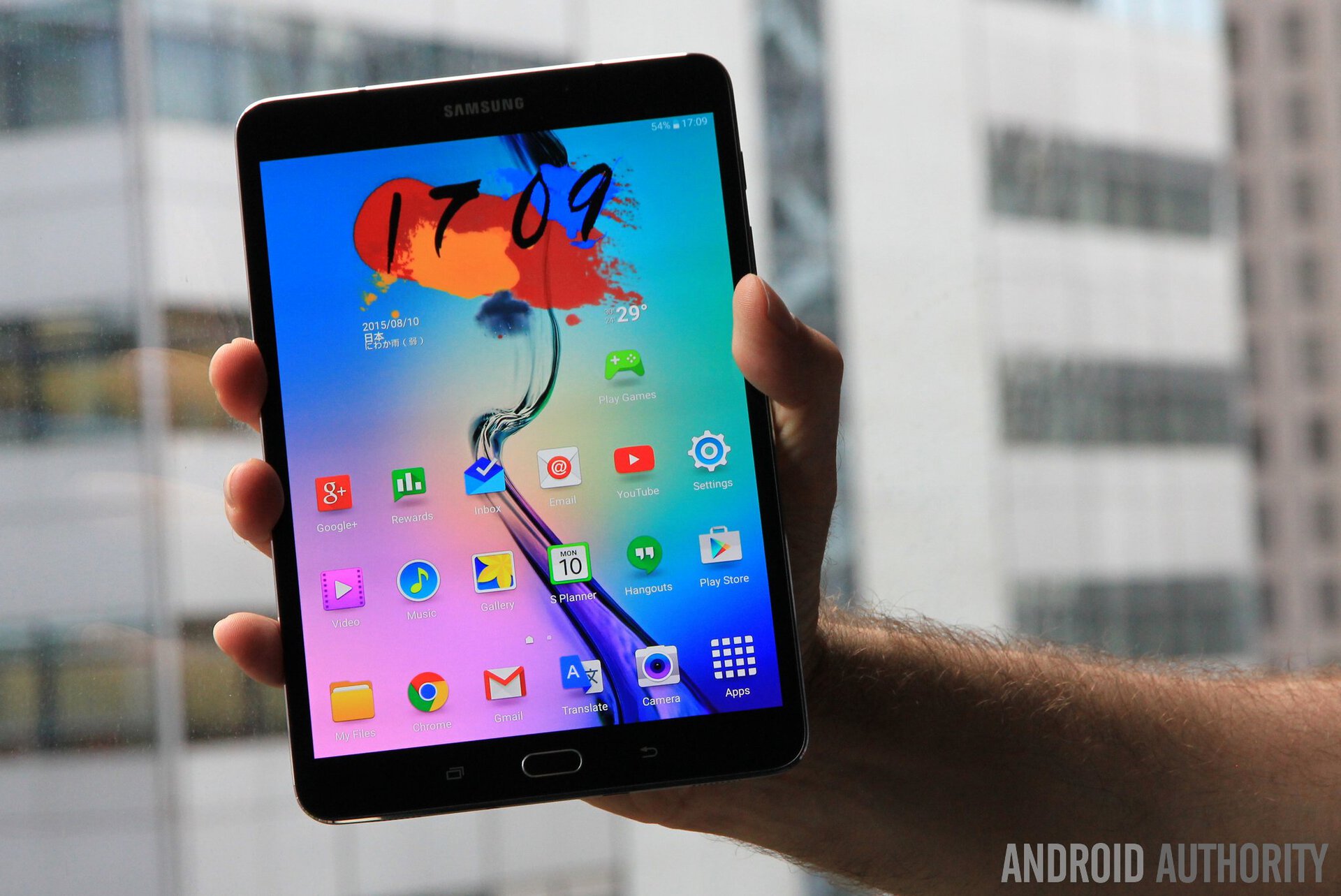
The advent of Super AMOLED into the realm of tablets was a foray Samsung fans across the globe were eagerly awaiting. While the Korean conglomerate had previously tinkered with it back in 2012 when the Galaxy Tab 7.7 released, neither hide-nor-hair had been seen since. 2014 brought with it an incredible pair of products however: the Galaxy Tab S 8.4 and 10.5, each of which was equipped with a stunning QHD SAMOLED display. This dynamic duo was positively received by the tech community for the fantastic screen and thin and light build.
You might like: Best Galaxy Tab S2 9.7 cases
The Galaxy Tab S2 has now arrived and, after spending some time with the Hong Kong import model, we have initial impressions to offer, as well as overall thoughts and commentary on the product at-large and the changes it brings with it. Note that our official, formal review will follow in the coming weeks.
Introduction and specs
Before sharing our initial thoughts, let’s first address the specs and therefore set expectations about the tablet itself.
The Galaxy Tab S2 comes in an 8-inch, and 9.7-inch variant, both of which employ a 4:3 aspect ratio 2048×1536 SAMOLED display, and is available in LTE and Wi-Fi-only configurations. For the purposes of this impressions piece, we have tested the 8-inch Wi-Fi only model.
Samsung's 2015 tablets seem to be on a sliding scale of sorts: the Tab A wasn't equivalent to the Galaxy A, nor is the Tab S2 equivalent to the Galaxy S6.
The Tab S2 features an Exynos 5433 Octa-core SoC, 3GB of RAM, 32 or 64GB of on-board storage, and an 8-megapixel rear, 2.1-megapixel front camera set-up (no flash, sorry). It ships with Android 5.0.2 and features the same “touch-based” fingerprint sensor used in the Galaxy S6. MicroSD support is included by way of an eject pin; the tray is built into the frame.
The 9.7-inch variant includes a 5,870mAh battery, and the 8-inch variant a 4,000mAh power-cell. Both devices are available in either black or white, though select Asian markets like Taiwan seem to be getting a Gold variant for good measure.
The tablets are just 5.6mm thick and employ an aluminum frame, but soft-plastic rear panel. The smaller Tab S2 will, in LTE-configuration, include an earpiece for voice calls, however this feature is typically removed from the US carrier-based models.
Touting the tablet
Samsung’s 2015 tablets seem to be on a sliding scale of sorts: the Tab A wasn’t equivalent to the Galaxy A, nor is the Tab S2 equivalent to the Galaxy S6. The Tab E is more like a Galaxy J, the Tab A is more like a Galaxy E, and the Tab S is more like a Galaxy A. This raises the fair question of just if (or perhaps when) a “real” flagship tablet will be announced. Given the mysterious shape that appears along side the Galaxy Note 5 and Galaxy S6 Plus Edge on the Unpacked 2015 promotional advertisement, there is a strong feeling that this week will bring with it the announcement of a Galaxy Tab Edge that will, in a sense, put the Tab S2 in its “proper place” in the pecking order.
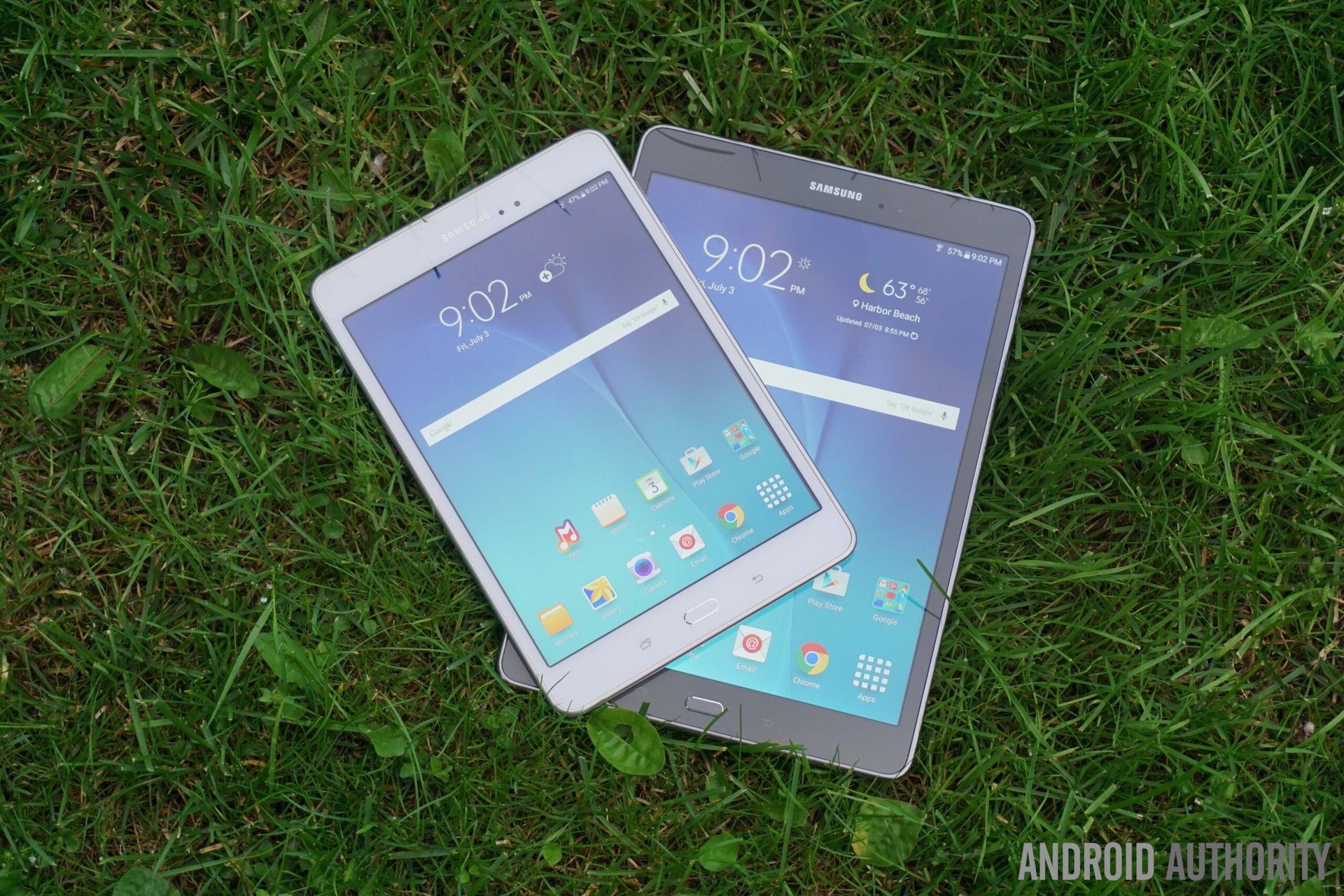
The fact that the product ships with Android 5.0.1 means it’s already out of date. Samsung has never prioritized tablets when it comes to updates, and considering that it will launch the Galaxy Note 5, Galaxy S6 Edge Plus, and possibly a Galaxy Tab Edge in the coming days means there are far larger tasks to tackle. Curiously the Tab S2 already includes at least one of the changes implemented in TouchWiz for Android 5.1: the ability to manually deactivate the S-Finder and Quick Search tabs from the notification shade.
Schooling the screen
While we will go into greater detail about the perks (or problems) with a 4:3 aspect ratio, many are inevitably curious about the Tab S2’s display. It is indeed sharp and beautiful, and brings with it all the benefits of an OLED panel, namely the near-infinite contrast and deep, saturated colors. As with all top-end Samsung products, the Tab S2 lets users select from one of four color-saturation modes so that those less interested in the “comical” level of coloring on AMOLED Cinema can scale things back.
Despite the high resolution and beautiful colors. for some reason the display never looked quite as amazing as that of the original Tab S. I am ultimately not sure why; it could be the reduction of pixels from QHD to the hybrid-resolution employed here, it could be a result of the deep black bezel, it could be simply because I’ve acclimated to the high resolution via other products and thus even on a tablet it simply doesn’t seem as magical as the 2014 Tab S which was released at a time when QHD tablets were less common.
Cost cutting corners
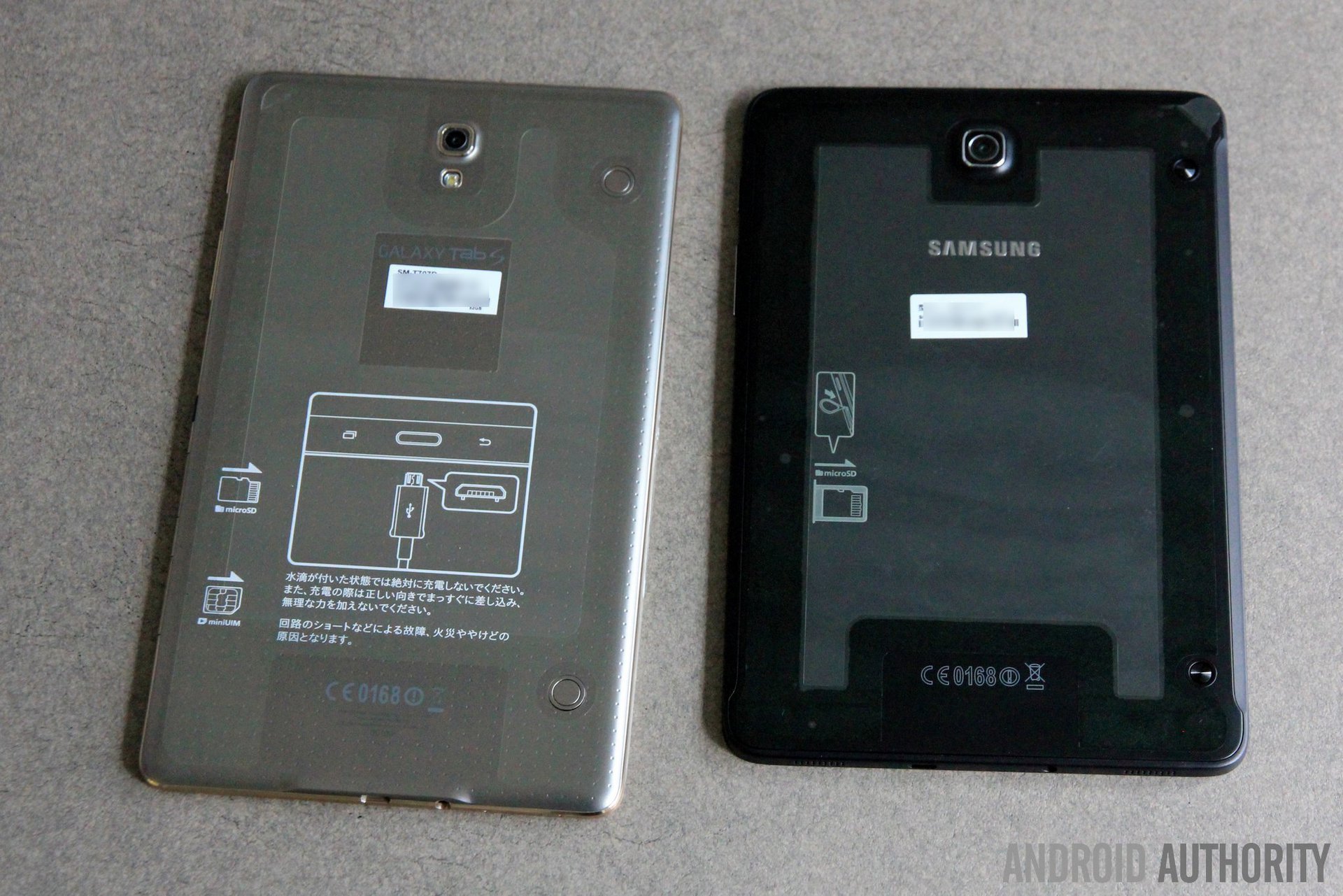
Just as we saw with the Galaxy A8 last week, Samsung’s decision to cut costs with products seems to be made irrespective of the price tag attached. The Galaxy Tab S2 lacks a notification lamp, a camera flash, an IR-blaster, and at least with the Wi-Fi model we tested, a vibration motor. With respect to the LED this is something that wasn’t present in last year’s models either, but the absence of IR transmission, a camera flash and vibration smacks of trying to squeeze out every last possible part that might justify the premium price tag, let alone a Galaxy S-class product. For reference there is no NFC present either.
I also found TouchWiz to be lacking as well. There is no ability to activate the parallax background effect for those who want it, yet Samsung did include the ability to choose up to 30 different lockscreen wallpapers. There is no Theme Store, something that would be seemingly perfect for a large device like a tablet, and something Samsung has been pushing on even mid-range phones these days. There is no Magazine UI to be found, instead opting for the same Flipboard Briefing panel that is found on the Galaxy S6.
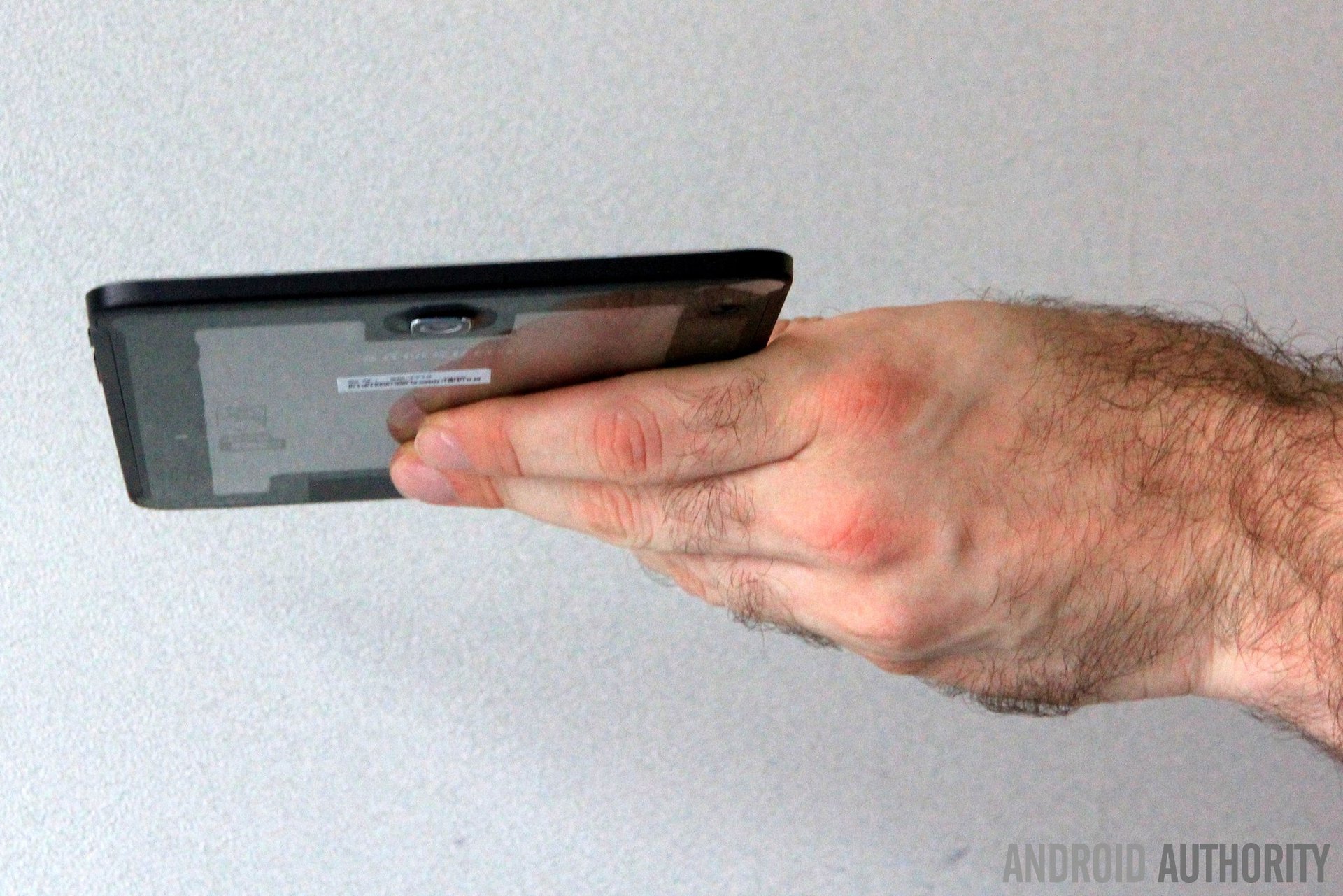
Honestly speaking, many of these missing features or components are things that I don’t personally care about, but some customers will. When the price of a device doesn’t decrease from year-on-year, I would at least expect there to be some things added or at the very least, left the way they were.
Sound situation
Ironically if one were to suggest the Galaxy Tab S2 was not aimed at the media-consumption crowd due to the aspect ratio, the speakers would only work to serve as fodder for your cannon. Last year, Samsung did the seemingly unthinkable and put stereo speakers on the Tab S. And it separated them: one on either side be it the Tab S 8.4 or the Tab S 10.5.
This year, the speakers are both located along the bottom of the device and they couldn’t be worse. Playing a YouTube video on 80% volume was relatively loud, but the sound quality itself was truly nothing to write home about, especially if there was any kind of competing noise in the background (like a fan, for example). When I cupped my hands to the speakers things improved somewhat, but all-in-all even the single rear-firing speaker on the Galaxy A8 produced better, louder, crisper sounds than this tablet does.
The main problem is, at least with the Tab S2 8.0, when you hold it in landscape mode, your finger(s) are always going to naturally be in a position to block one of the stereo speakers. This results in further muffled sound quality and you might not even be aware of the problem. Suffice to say this issue could have been largely avoided with speakers on opposing sides wherein you could hold the tablet in an orientation such that neither hand was blocking the sound.
Build quality blues…or benefits?
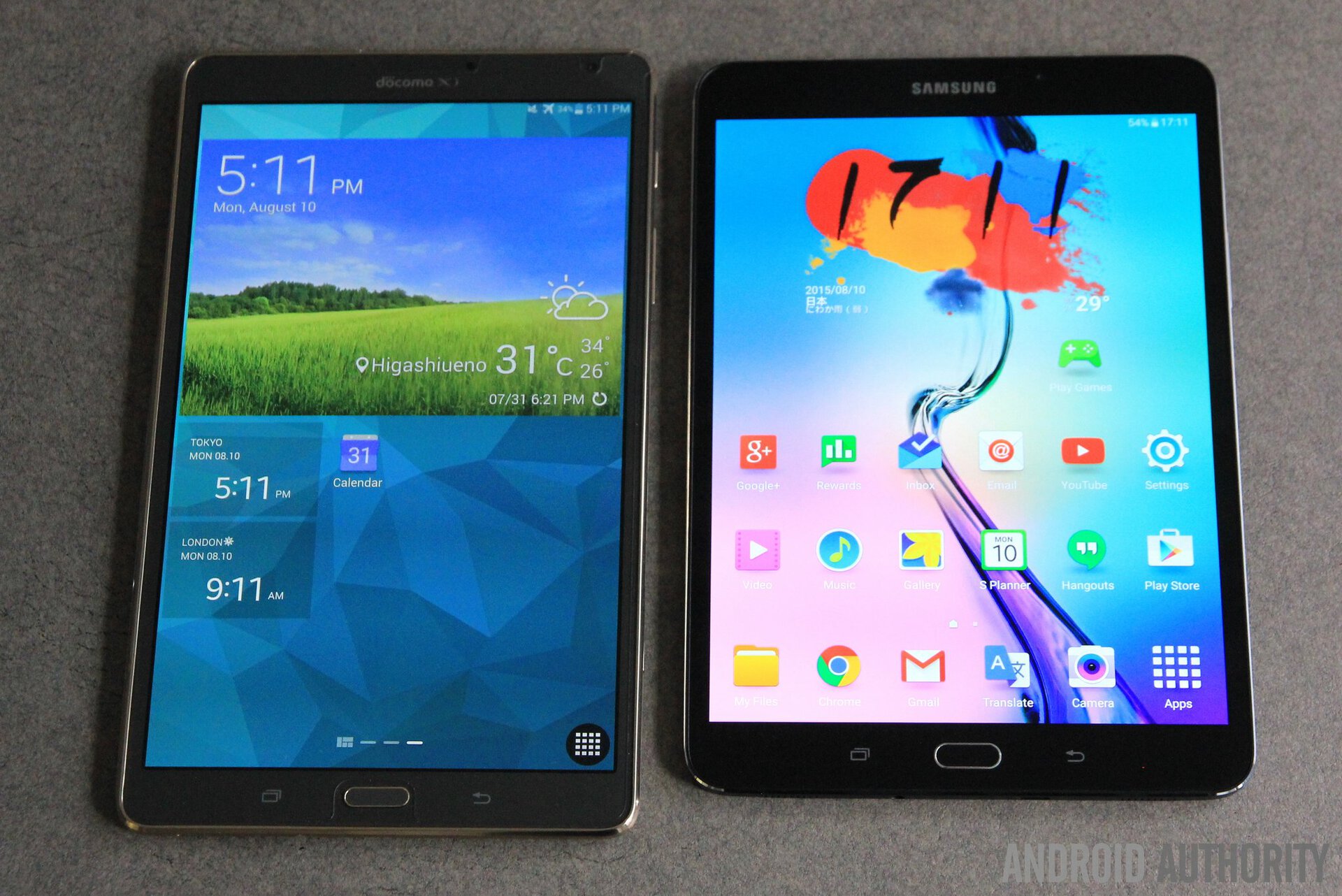
As had been widely leaked in the months and weeks leading up to the Tab S2’s official unveiling, the device makes use of an aluminum perimeter around the tablet but with a soft-touch, almost rubber-esque plastic on the rear. Much like the Galaxy Alpha, it feels as if the entire heft of the product is generated by the lightweight metal. In the case of the Tab S2, the overall impression I had was quite nice. The rear in particular feels comfortable and even soothing to the touch, and markedly different than the harder, “porous” rear that was seen on last year’s models.
I liked the ergonomics of the device: despite the wider body size, it was still comfortable to hold in the hand and the contours along the underside of the frame are quite reminiscent of what Samsung has used for the Galaxy A8. Even the docking pegs for the Book Cover are smaller and look much nicer than the bland discs from 2014.
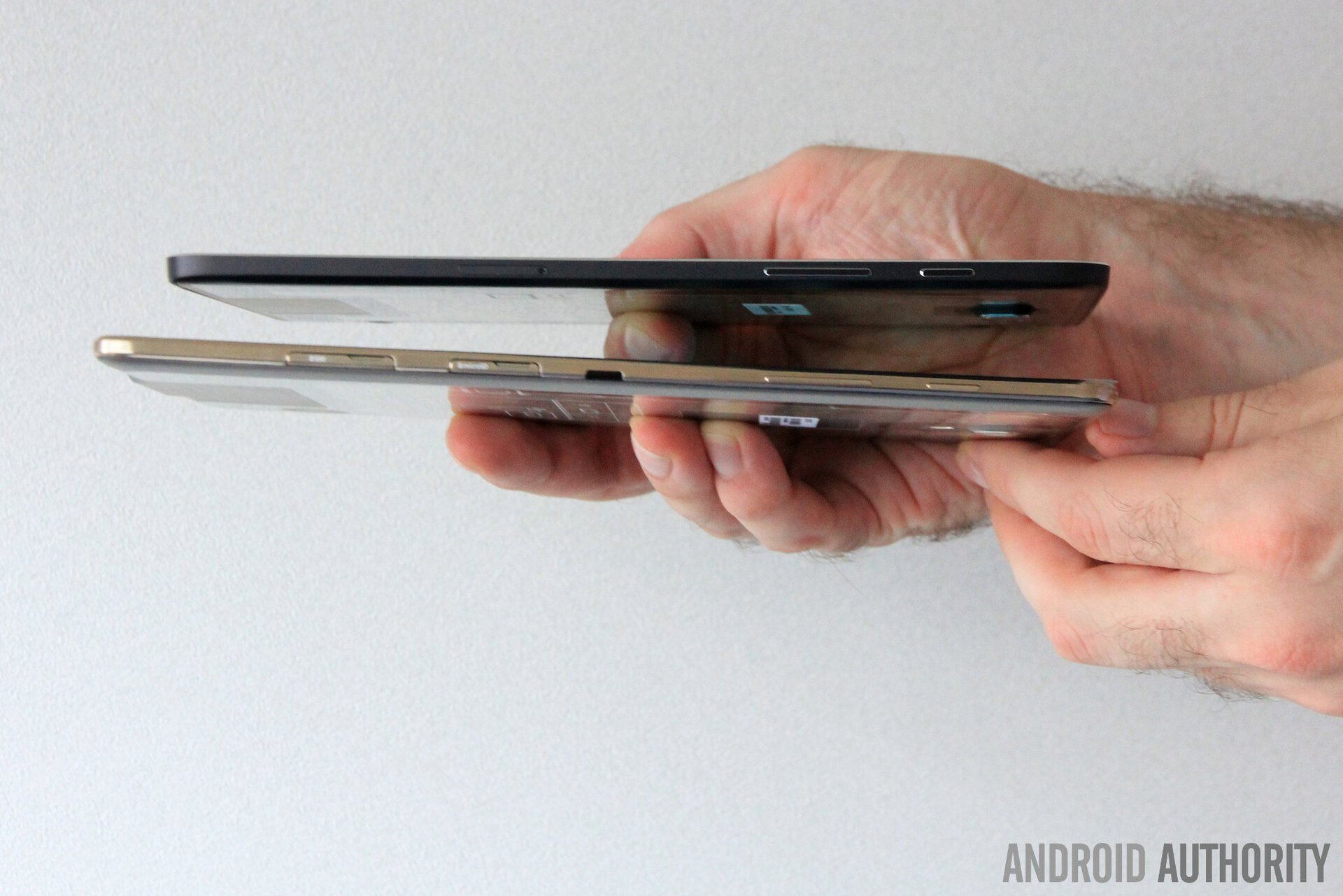
As is typical with Samsung’s questionable quality control, my Galaxy Tab S2 arrived with defects present. Specifically, the metal frame had scratches on several places along the perimeter. Why it is Samsung feels the need to paint 90% of the frame black yet leave the 2014-era Galaxy Note 4 “tracing” of silver along the edge is totally at-war with the design aesthetic employed by not only the Galaxy S6, but the A8 as well. I will unfortunately be direct here and state that the painted frame is nothing short of hideous, though for those who loved the Note 4 or Note Edge it will probably come off as quaint.
“Button”-bashing
One other gripe I have about the build quality is the fact that the capacative buttons that flank the fingerprint-sensing home button are literally painted onto the screen. I’m not quite sure why Samsung felt the need to do this, though in truth the OEM has yet to do otherwise. Something about the metal frame however, coupled with the relatively compact size of the tablet just make the always-visible buttons less bearable. If even the Galaxy A8 can feature “vanishing” ones, why can’t this tablet as well? Is Samsung worried that users might forget where they are?
Beyond this personal gripe, there is once again no default way to alter the backlight on-time of the capacitive keys. They remain lit for roughly 3 seconds, then disappear. This, coupled with the lack of haptic feedback when pressing them (again at least on the Wi-Fi model) really just irked me.
“Begun the Clone Wars have”
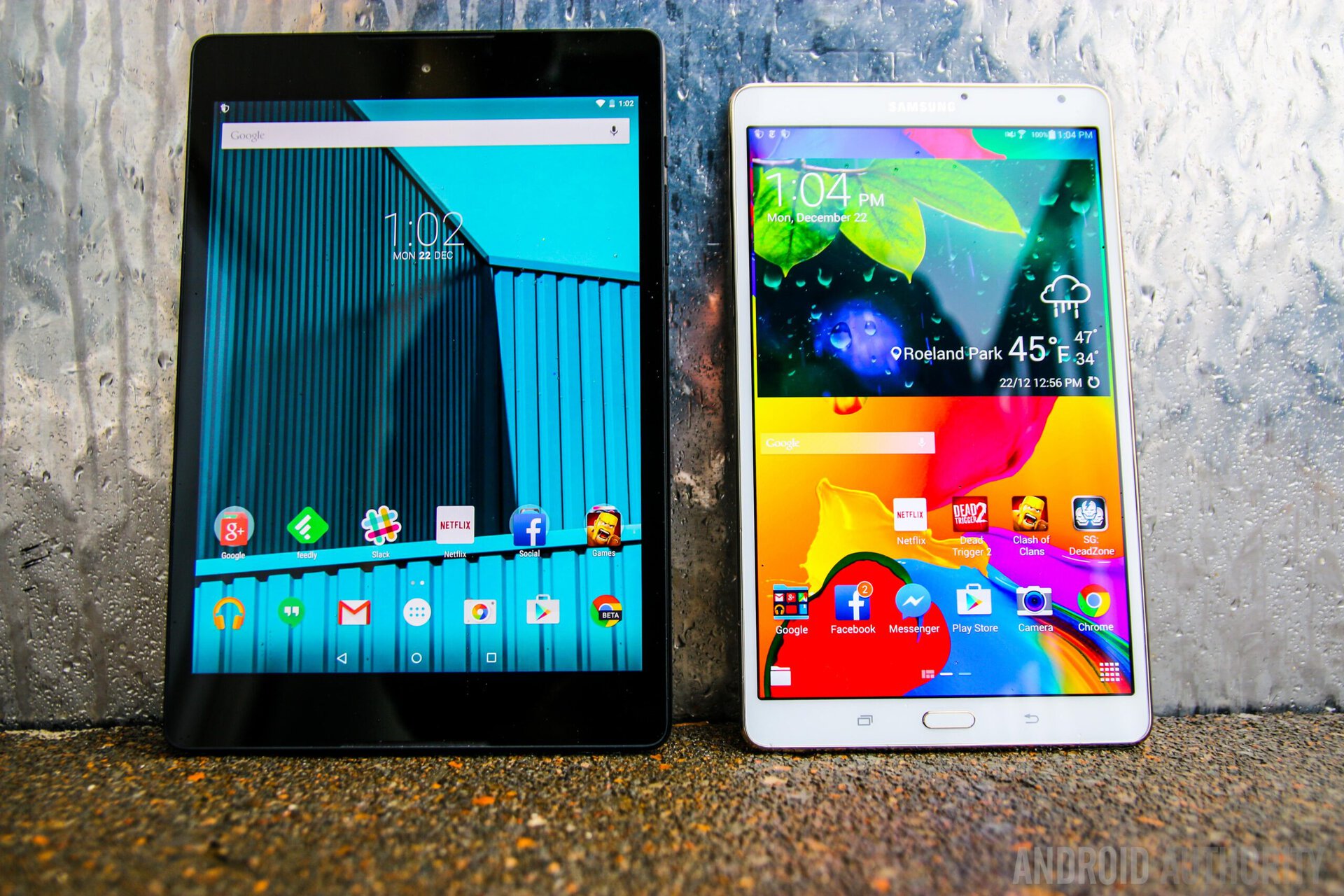
Google’s release of the Nexus 9 last year was arguably the perfect panacea Samsung had been searching for all to aid tablet maladies. In its purported attempts to clone the iPad over the years, Google’s own adoption of a 4:3 aspect ratio for its perennial tablet meant that all lights were green to go with 4:3 Galaxy Tab models in the coming year. Indeed not only does the Galaxy Tab S2 resemble the iPad Mini, but it can literally fit comfortably inside a case for Apple’s product as well, though button placement issues create for problems.
I would at least expect there to be some things added or at the very least, left the way they were.
While using the Tab S2 in public, several of my friends or acquaintances asked if I had purchased an iPad. This, despite the prominent Samsung logo at the top. In truth some probably would have even were this the Tab S 8.4 simply because Apple “invented” the tablet. While there are indeed sizable benefits in opting for full-screen aspect ratio, it seemingly goes without saying that the direct competition with Apple’s iPad is indeed what Samsung had hoped.
At least the camera is a step-above the typical tablet fare. While these samples are not stunning, at least things have improved in the past few years.
Performance anxiety
When news broke that the Tab S2 was to use the same SoC as last year’s Galaxy Note 4 (the Exynos 5433), a sizable number of readers were not happy. Instead of opting for the fast, relatively brand new Exynos variant found in this year’s Galaxy S6, Samsung went with an aging chip. While I didn’t notice anywhere near the amount of lag that occurred with the Galaxy A8 testing, there were some occasional stutters. More often than not however, the problems arose from random app crashes, usually games.
Take a look at the various scores and comparisons that two tests on AnTuTu resulted in:
So yes, despite the fact that the Galaxy Tab S2 has the same SoC present in the Note 4, it actually performs worse in this benchmark test, as it does any number of devices from last year, including the One Plus One.
4:3 is good for me?

For almost half a year now, comments have been coming forth about the idea of Samsung using 4:3 full-screen aspect ratio for its 2015 tablets. When the first affirmation finally arrived, some were quite brutal. Truth be told, the use of a full screen aspect ratio isn’t the end of the world at all. The public opinion that 16:9 is the golden ratio of viewing is really based on the working assumption that all products made before the advent of the DVD were somehow “wrong”. Apple has sold hundreds of millions of iPads however, all of which make use of this controversial proportion. Is it really that bad?
Productivity
One of the benefits of 4:3 is that typing is an absolute breeze. The fatter nature of the screen means that in portrait orientation, basic activities like typing tend to be easier to do. Smaller widescreen tablets are often too “cramped” for those with larger hands, much like widescreen phones. Having the extra space means you may have an easier time typing. I sure did.
The nice wide handling of the Galaxy Tab S2 means that you can get work done on it, and indeed most of this review was actually typed on the Tab S2. It was an overall fantastic experience to say the least, something that I absolutely could not say applied to the Tab S 10.5, and only moderately-well on the Tab S 8.4 – for me at least; others may beg to differ.
Media consumption
This might be mutually exclusive, but I don’t watch movies on my tablet or phone. Were I flying often, or sitting on a train for long periods of time, this might not be the case. The same goes for if I was a child or passenger in a car. Still, at the end of the day, I don’t watch movies on my phone. What then, do I use it for? Typically, browsing the web.
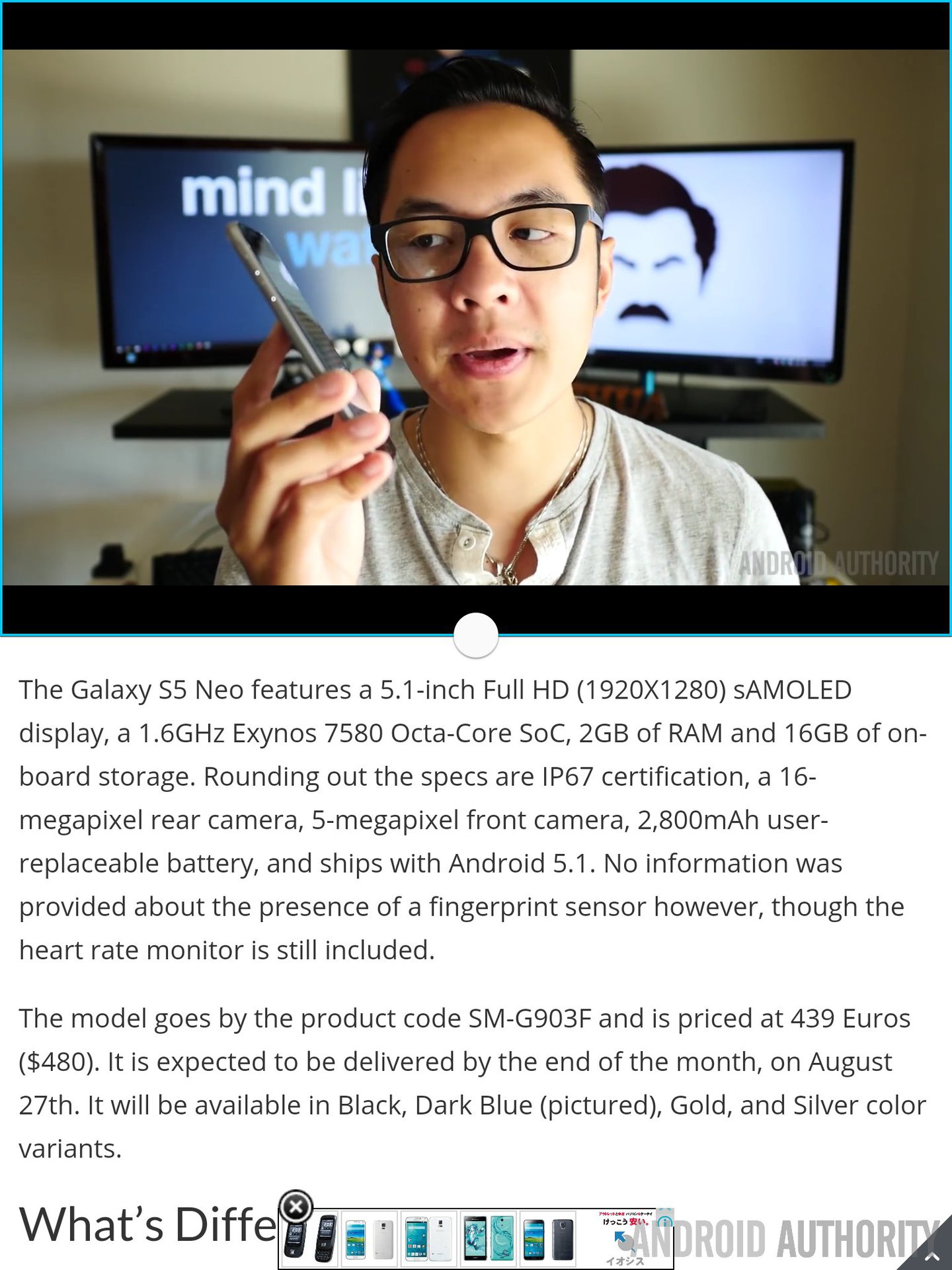
As you might imagine, the ability to view a website in 4:3 aspect ratio therefore allows far more of the printed text to fit comfortably on-screen, and it lends itself perfectly to things like e-books. Everything is less squished, everything tends to fit on the page nicer, there is less scrolling necessary because the text can better fit horizontally, etc. It’s the same exact things you might hear Apple or Google say about their newest tablets.
While I don’t claim to represent the majority of people, I would argue that there are many individuals who also use their phones (or tablets) primarily for internet use or other tasks. For us, the 4:3 aspect ratio just works better. Given that Apple in particular has pushed 4:3 iPads for so long, and they have been so successful, it’s also clear that many are willing to forgo widescreen when push comes to shove. Samsung will likely not get the benefit of the doubt here given that media purists accept nothing less than 16:9-esque ratios.
A problematic reality
With all this said, there’s a major problem with things like YouTube videos. Take a look at the screen capture below to gain an immediate understanding:
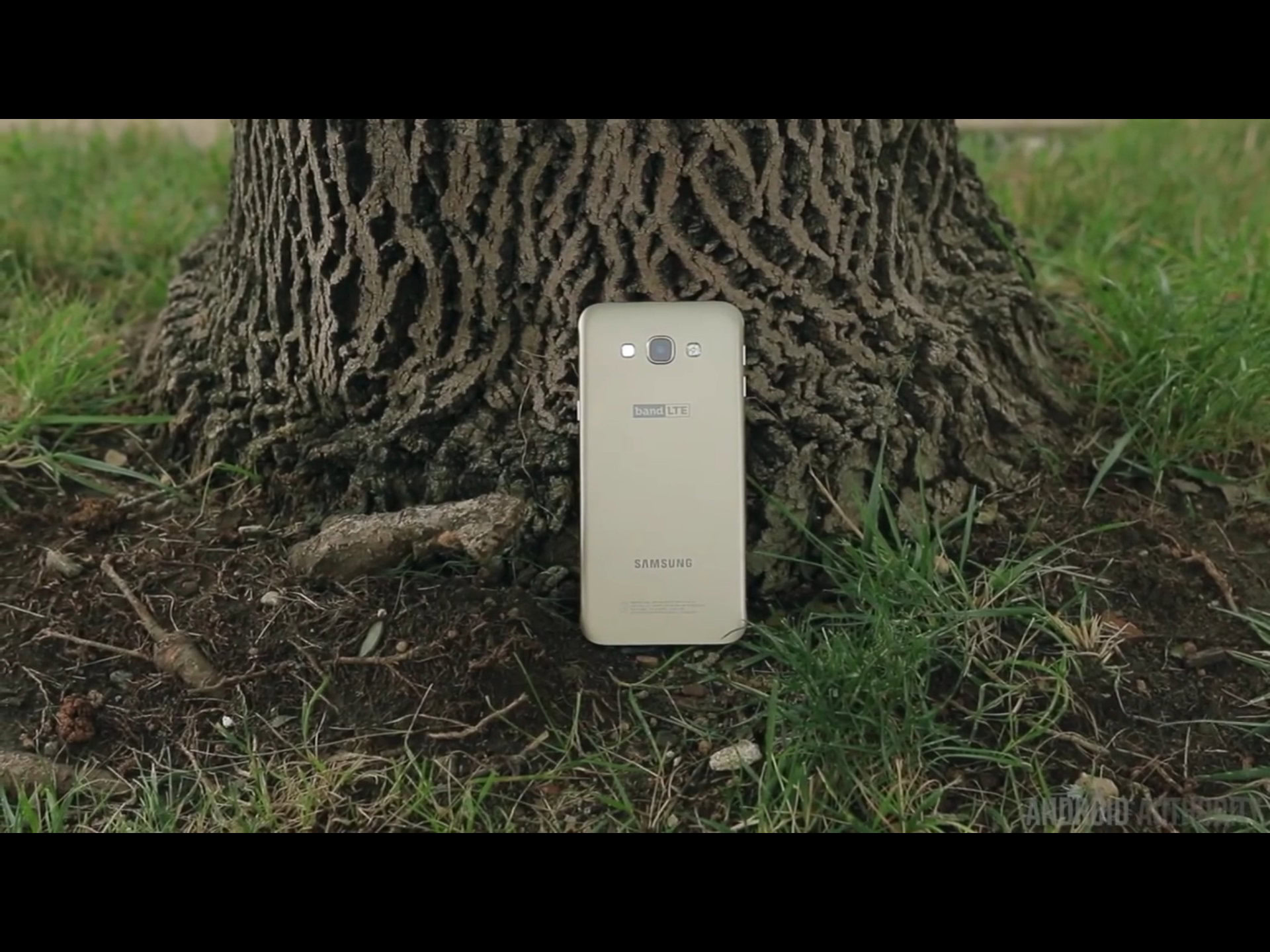
The problem here has less to do with the Galaxy Tab S2 and more to do with the simple fact that almost all media now created is done in 16:9 format, or something similar. I will fully admit that for all the benefits personally gained with respect to reading, typing, browsing, or even game playing, the times when I used the Tab S2 for watching YouTube was met with some displeasure.
If you end up springing for the black-color variant like I used for this piece, the bars will seemingly blend in with the unit itself. With a white (or gold) variant however, things look to be much more potentially problematic. At the same time however, the “seamless” nature of the black model will ironically make the screen bezel look absolutely gigantic, not unlike the old BlackBerry PlayBook or Xperia Tablet Z.
Safe and Sound
I was truly, truly pleased to find that the fingerprint sensor used in the Galaxy Tab S2 works just as perfectly as it does in the S6, S6 Edge, and Galaxy A8. Mind you it is the same senor, but after the experiences I had with the thing included in last year’s Tab S, it was nice to actually use this one. Four different finger readings can be added as per other devices, and you simply need to press the desired digit on the sensor to unlock. It’s effortless and happens in a snap. No swiping, no redoing, no frustration.
Granted for those who typically use a tablet at home exclusively, the idea of locking it to begin with might seem unnecessary, but for people like myslef who take them to work or on travel for business-related use, the effortless security standard is a nice thing to have.
Praising the Power (Cell)
Battery wise the Tab S2 certainly managed to impress. One of the largest flaws that people complained about with last year’s model was the battery, namely how quickly it depleted and subsequently how long it took to recharge. The tablet managed to go an entire day with heavy use, for example, and still had 50% remaining by the end. This include sending emails, typing this piece, playing several games, listening to music, doing benchmark tests, etc.
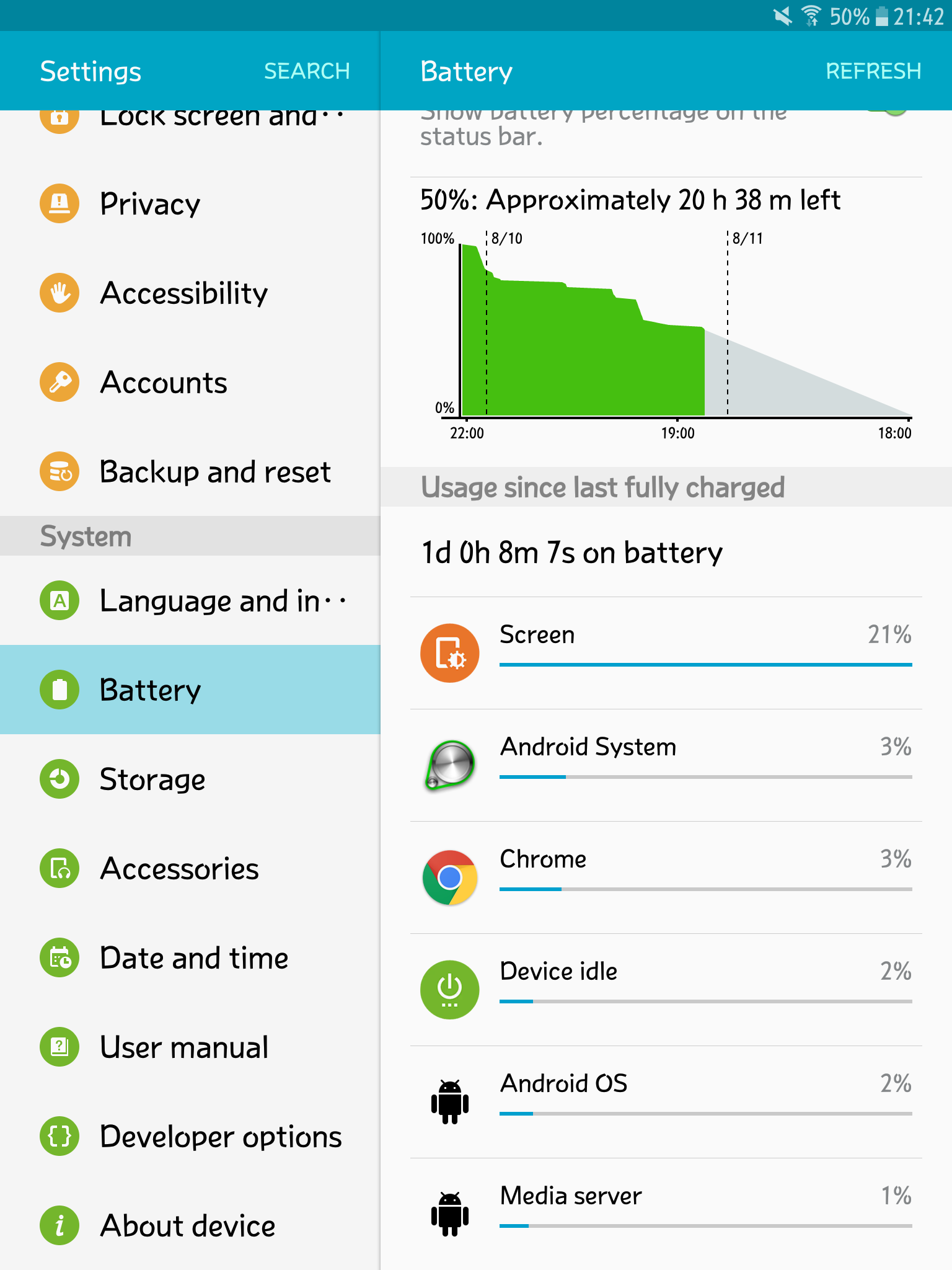
One aspect that might be in play here is the lower resolution of the screen as per the aspect ratio; it’s not technically QHD simply because there aren’t enough pixels to be classified as such. Another issue could be some of the cost cutting measures Samsung employed. As mentioned the lack of any vibration feature can factor in (though it’s likely the LTE model will retain it) as does the quick power-off of the capacative key backlighting, and the lack of the parallax-background wallpapers seen on the Galaxy S6.
I had spent a considerable amount of time with the Korean Tab S 10.5 LTE-A model which actually used the same SoC found in this product, and the battery life was awful. Samsung definitely managed to score some major points with this product and longevity, something bolstered by the inclusion of Ultra Power Saving mode.
Wrap Up
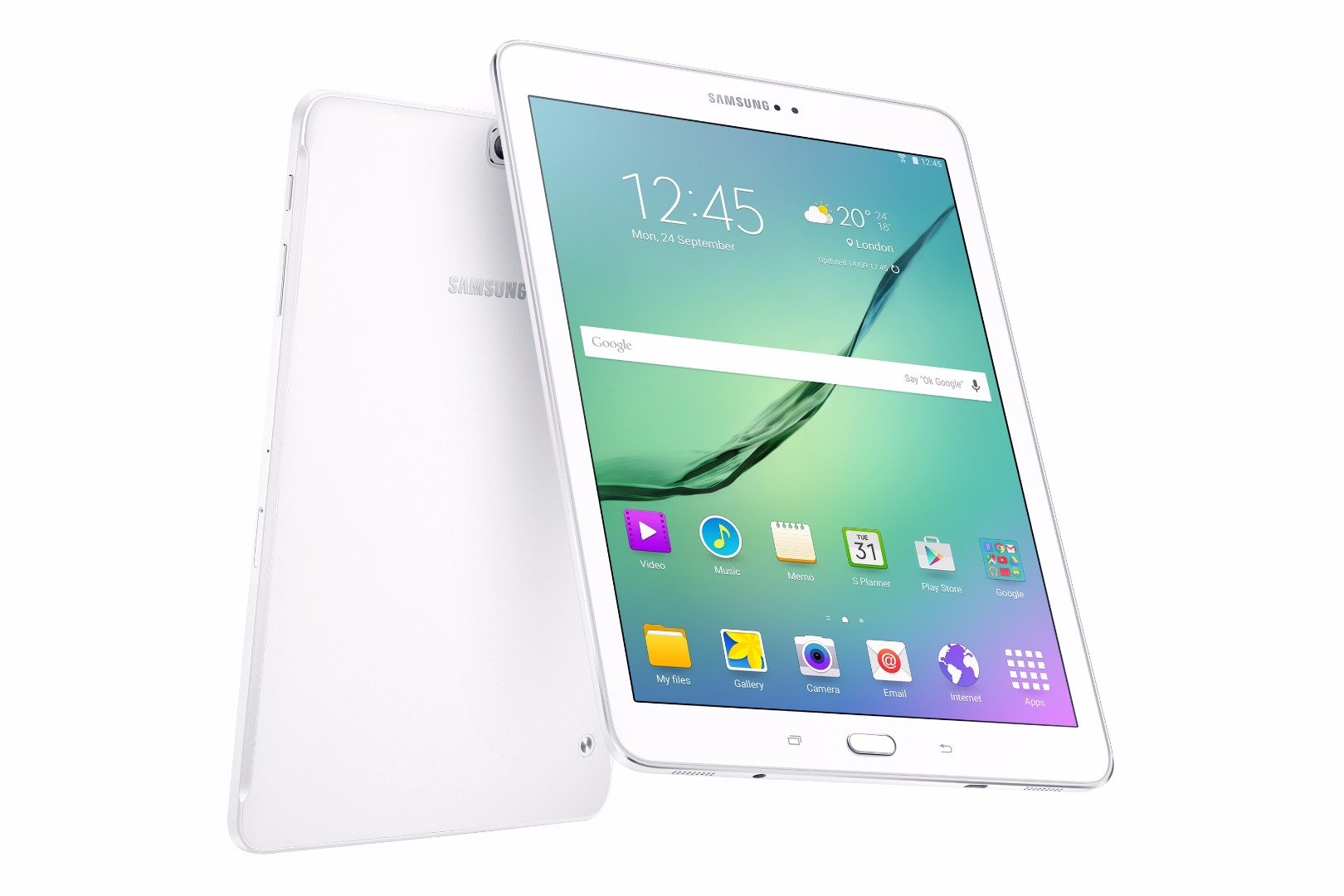
In deciding how to evaluate the Galaxy Tab S2, it is an issue of price, priority, and purpose. The specs inside unfortunately do not equate to flagship, not by far, and thus the cost may be quite a high one to swallow. Likewise the decision Samsung made to use 4:3 aspect ratio is also equally troubling for a large number of people, even if some (like yours truly) find it to be that much more endearing because of the form factor.
They device will also appeal to anyone who is truly searching for a high(er) end Android rival to the iPad. Granted ASUS has its new 4:3 tablet, but in my own testing it the device was riddled with lag and performance issues, perhaps due in part to the combination of its overbearing OS skin and Intel’s CPU.
So what do you think? Are the benchmarks problematic? Does this make a good purchase for you or your family? Let us know in the comments below, and keep an eye out for our full, detailed review in the near future!